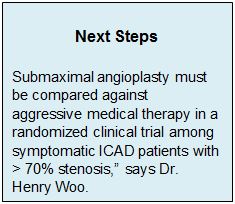Key Points:
- Single-center study looks use of submaximal angioplasty to treat ICAD patients
- Procedure proves feasible to perform, safe over 1 year of follow-up
Angioplasty using an undersized balloon, otherwise known as “submaximal angioplasty,” may prove to be an alternative treatment for intracranial atherosclerotic disease (ICAD). A phase I study published online January 8, 2016, ahead of print in the Journal of Neurosurgery suggests the technique is feasible and safe.
Adnan H. Siddiqui, MD, PhD, of the University at Buffalo (Buffalo, NY), and colleagues performed submaximal angioplasty using a balloon undersized to 50-70% of the nondiseased vessel diameter. After screening 65 patients, they enrolled 24 patients (mean age 64 years; 63% men) with symptomatic ICAD and angiographically significant stenosis of ≥ 70% who were being treated at a single center.
Patients were followed prospectively, with the primary outcome measure being the incidence of periprocedural complications, defined as the combined rate of death, stroke, and hemorrhage occurring within 30 days and at 1 year.
Concomitants of vascular disease were commonly present, including hypertension (95.8%), hyperlipidemia (70.8%), smoking history (54.1%), and diabetes (50.0%). Also frequent were coronary artery disease (41.7%) and previous stroke or transient ischemic attack (45.8%). Most patients (75%) had anterior circulation stenosis.
Mean preprocedure stenosis was 80.2%. After submaximal angioplasty, the mean degree of stenosis was 54.6%.
Rates of ischemic stroke in the territory of the treated artery were low (5.55% at 1 year), and there were no deaths or hemorrhages within the first year following treatment.
Stepping Stone to Larger Trial
In an interview with WLNCMD, Dr. Siddiqui described his study as a “back to the future situation,” because submaximal angioplasty began to be investigated for the treatment of ICAD prior to the development of intracranial stents. In 2000, he said, the WASID trial demonstrated that stroke risk remained high among patients with ICAD and > 70% stenosis treated with medical therapy alone.
“We started treating those patients with coronary angioplasty balloons [and learned that] if you tried to make the artery look normal, you were courting disaster, but if you made a small change in the radius of the artery, that makes a tremendous difference to the flow of blood through the vessel,” Dr. Siddiqui explained. “We found if you undersized the balloon, you could alleviate the acute symptoms these people were having [with a greater margin of safety].”
Interest in balloon angioplasty waned with the advent of stenting, until SAMMPRIS revealed that, with uptake of dual antiplatelet therapy, medical therapy alone had superior outcomes to stenting. Now, there is renewed interest in alternative interventional approaches to management of symptomatic ICAD that fails to respond to medical therapy, according to the researchers.
And the indication may be even wider than that. Henry Woo, MD, of Stony Brook University (Stony Brook, NY), pointed out in a telephone interview with WLNCMD that the medical management arm of the SAMMPRIS trial was so aggressive that it may not be universally reproducible outside of a research setting.
The current study, said Dr. Woo, is one of many necessary steps toward a large, multicenter clinical trial in which patient with symptomatic ICAD and stenosis > 70% are randomized to submaximal angioplasty or aggressive medical therapy. Such a trial is needed to determine the true benefits of submaximal angioplasty but will not likely get off the ground unless it can be shown first that the treatment can offer lower periprocedural complication rates. “Otherwise, naysayers will say, why bother doing it?” he predicted.
Source:
Dumont TM, Sonig A, Mokin M, et al. Submaximal angioplasty for symptomatic intracranial atherosclerosis: a prospective phase I study. J Neurosurg. 2016;Epub ahead of print.
Disclosures:
- Drs. Siddiqui and Woo report no relevant conflicts of interest.


